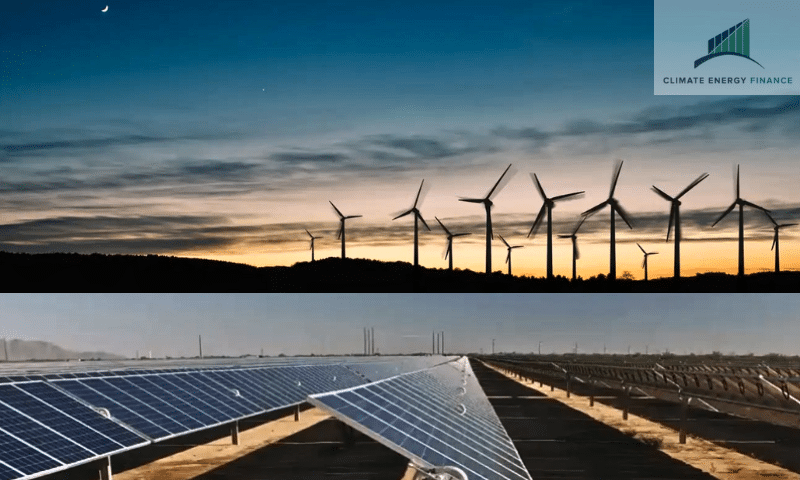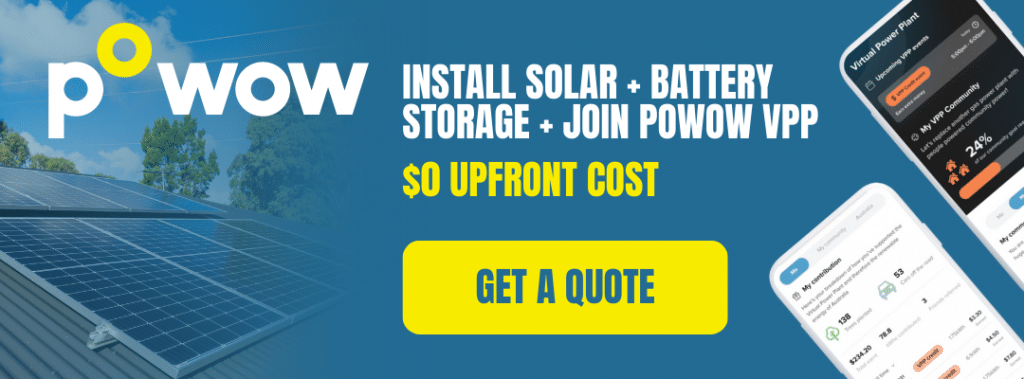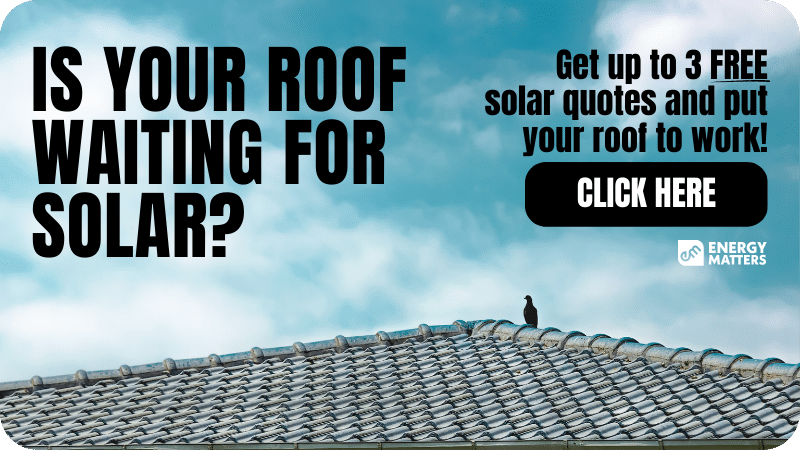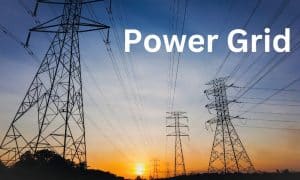The global solar power industry is experiencing unprecedented growth, driven by falling costs, increasing manufacturing capacity, and record-breaking annual installations. The solar boom has significant implications for the energy transition and climate change mitigation efforts, potentially accelerating the decline of the fossil fuel industry.
The transition to solar power, coupled with advancements in solar panels, wind, battery storage, electric vehicles, and electrification, substantially reduced the cost of solar power systems across Australia. This cost reduction will undoubtedly encourage more homeowners, businesses, and communities to adopt solar energy solutions, ultimately accelerating the country’s transition towards a greener and more sustainable future.
Still can’t afford to switch to solar power? Are you considering getting solar panels but are currently short on funds? You can still invest wisely, and Energy Matters can help you.
Powow and Energy Matters have teamed up to provide consumers with an alternative to switching to solar power and battery storage.
The biggest obstacle to installing solar and battery storage is typically finance. With Powow’s PPA and VPP, our customers will have a $0 upfront option and financial stability in the uncertain energy market.
Get up to 3 obligation-free quotes by getting in touch with us right away. Find out what payment plan options suit your needs and budget!
Check out our page for Powow: Power Purchase Agreement (PPA) and Virtual Power Plant (VPP).
A series of key findings by Climate Energy Finance (CEF) highlights solar power’s current momentum and future potential, along with its implications for global energy markets and climate change mitigation efforts.
Price deflation and manufacturing capacity
According to the Silicon Pivot analysis by analysts Tim Buckley, CEF Founder and director and Xuyang Dong, CEF’s China Energy Policy, polysilicon prices, a key component of solar modules, have dropped by two-thirds since December 2022, reaching just US$11/kg in June 2023. As a result, solar module prices have decreased by a third since 2021, averaging US$18c/watt in May 2023. Global freight costs have also reduced by over 80% from their peak in late 2021. CEF expects solar electricity costs to continue declining by 10% annually throughout the decade, effectively halving by 2030.
Solar manufacturing capacity has also witnessed substantial growth. In 2022, global solar module manufacturing capacity will reach 600 GW, and planned expansions are projected to double this capacity by 2024-2025. China leads the way with the majority of expansions, while the United States, India, and the European Union (EU) are also planning significant capacity increases.
Booming solar investments
Solar investments worldwide are surging, with the trend expected to gain further momentum in 2023. Solar power is becoming the most cost-effective source of new electricity generation in many markets, even without factoring in carbon emissions pricing. CEF predicts that solar costs will halve again by 2030, leading to a profound disruption of global energy markets and a significant push towards renewable energy.
Global Implications for the energy transition
The accelerating growth of solar power and its expanding manufacturing capacity has profound implications for the global energy market transition. This trend offers a unique opportunity to address the climate crisis at the necessary speed and scale dictated by scientific research. However, the International Energy Agency (IEA) has consistently underestimated the pace of solar deployments and the decreasing costs, resulting in a significant underestimation of the disruptive impact on the fossil fuel industry.
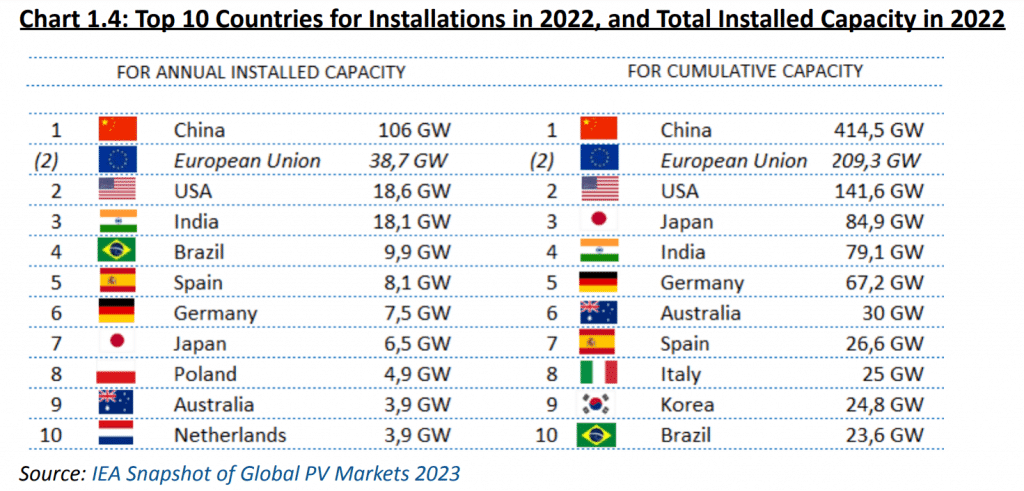
Record solar installations
Solar power installations have been setting new annual records consistently this decade. In 2022, the world installed a record-breaking 268 GW of solar capacity. CEF foresees the potential for global solar installs to reach 1,000 GW per year by 2030. This exponential growth in solar deployment will have far-reaching implications for electricity and energy markets worldwide.
China's dominance in solar
China stands as the leader in the global solar industry, with significant annual installations and solar module manufacturing capacity. It is expected to install 120-140 GW of solar capacity in 2023, accounting for 40-60% of annual renewable energy installations globally. China’s solar module exports have also seen substantial growth, with a 41% year-on-year increase, reaching 69 GW in the first four months of 2023.

LONGi exited 2022 with 133GW of wafer manufacturing capacity (Chart 4.4), as well as 50 GW of solar cell capacity, and produced 85GW of solar modules, generating collective revenues of Rmb129bn (US$18.6bn), representing a 60% yoy growth.
LONGi projects a 43-120% expansion of its total manufacturing capacity over 2023 alone.
In March 2022, LONGi agreed with the government of Ordos City, Inner Mongolia, for the construction of a manufacturing facility that will have a capacity of 20 GW for ingots and wafers, 30 GW for solar cells (of 25% conversion efficiency), and 5 GW for modules, and involve an investment of Rmb7.8bn (US$1.1bn). March 2023 saw LONGI confirm the board approved this project to proceed.
Solar power: A game-changer for Australia
Australia, possessing abundant solar resources, is expected to continue installing 4-6 GW of solar capacity each year. With 30 GW of installed solar capacity at the end of 2022, Australia is positioned to become a renewable energy superpower.
Analyst Tim said, “Treasurer Jim Chalmers should use the mid-year economic update to introduce a solar module production tax credit – time limited for a single decade – so Australia can secure our position in the solar production supply chain by deploying the world’s best solar cell technology, developed here by UNSW.”
“Australia’s massive headstart as a global leader in the uptake of distributed rooftop solar enables it to build on this lead and accelerate the rollout of household and business electrification of everything.”
Australia is focused on net zero emissions
The Australian government is committed to accelerating the transition from zero to zero. The Australian government has signed legislation that will limit greenhouse emissions by 43% versus 2005 levels by 2030. The government aims to achieve these goals through funding and investments in infrastructure. These commitments provide businesses with certainty to invest in new opportunities.
Check out our page to learn about Australia: Net Zero Emissions Target By 2050.
Energy Matters has been a leader in the renewable energy industry since 2005 and has helped over 40,000 Australian households in their journey to energy independence.
Let us discuss and choose the best quote that suits your needs and budget, and we can connect you with our trusted local installers, who will provide up to 3 FREE quotes for your home and business solar energy system. Get your free quotes today!
Other countries' solar initiatives
Countries worldwide are also experiencing a solar boom and investing in manufacturing capacity and installations. The United States, with the Inflation Reduction Act (IRA) driving clean energy investments, is set to expand its solar manufacturing capacity fivefold by 2024 and double its annual solar installations to 40-50 GW by 2030. India plans to triple its annual solar installs over five years and has introduced solar module import duties and incentives to encourage domestic manufacturing. The EU aims to quadruple its solar installations to 80 GW annually by 2030, prioritising energy security and self-sufficiency.
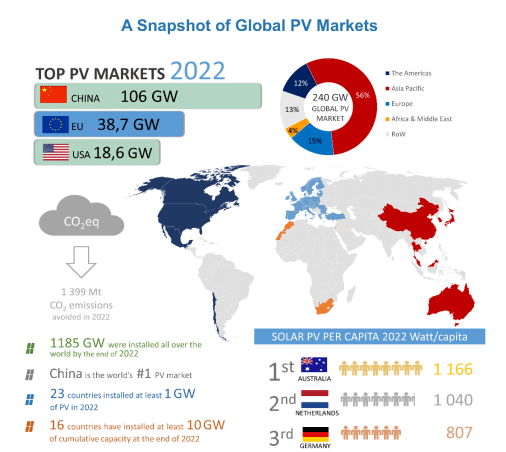
Implications for renewable energy adoption
The growing accessibility of affordable solar power presents a host of benefits for Australia.
Australia’s imminent future of cheaper solar power represents a significant step towards a cleaner and more sustainable energy landscape. As highlighted in the recent report, the surge in solar panel supply is expected to drive down the cost of solar energy solutions and make them more accessible to a wider range of consumers. By embracing solar power, Australians can play a pivotal role in reducing carbon emissions, combating climate change, and achieving energy independence. The potential for a greener and brighter future is within reach as the nation capitalises on the expanding solar energy market and government support.
Image&Sources: Climate Energy Finance, Australian Government Climate Change commitments, policies and programs
Attention, homeowners and business owners!
The clock is ticking, and the countdown to a greener future is on! Don’t miss out on the limited-time opportunity provided by the Victoria Solar Battery Rebate and Solar for Business Program! Act now and transition to clean, renewable energy while enjoying financial incentives. With the program concluding on June 30, 2023, seize the chance to reduce your carbon footprint, save money on electricity bills, and increase your energy independence.
So, why wait? Let us discuss and choose the best quote that suits your needs and budget, and we can connect you with our trusted local installers, who will provide up to 3 FREE quotes for your business solar and home battery system. Get your free quotes today! And apply for the Solar Battery Rebate and Solar for Business Program without delay, and make a difference that counts.











